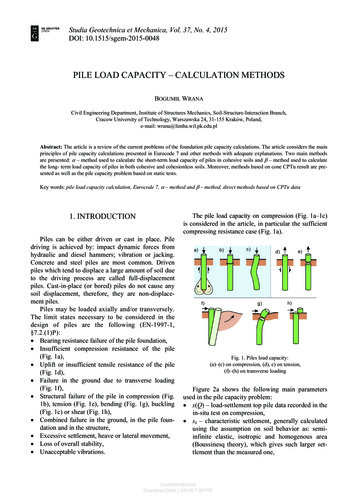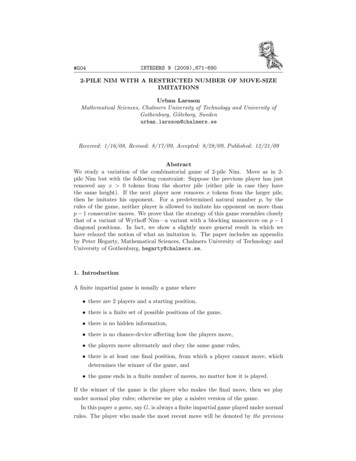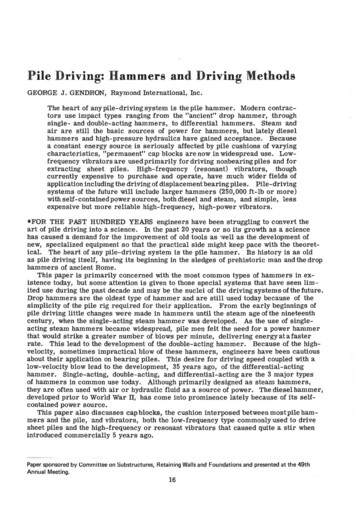
Transcription
Pile Driving: Hammers and Driving MethodsGEORGE J. GENDRON, Raymond International, Inc.The heart of anypile-drivingsystem is the pile hammer. Modern contractors use impact types ranging from the "ancient" drop hammer, throughsingle- and double-acting hammers, to differential hammers. Steam andair are still the basic sources of power for hammers, but lately dieselhammers and high-pressure hydraulics have gained acceptance. Becausea constant energy source is seriously affected by pile cushions of varyingcharacteristics, "permanent" cap blocks are now in widespread use. Lowfrequency vibrators are used primarily for driving nonbearing piles and forextracting sheet piles. High-frequency (resonant) vibrators, thoughcurrently expensive to purchase and operate, have much wider fields ofapplication including the driving of displacement bearing piles. Pile-drivingsystems of the future will include larger hammers (250,000 ft-lb or more)with self-contained power sources, both diesel and steam, and simple, lessexpensive but more reliable high-frequency, high-power vibrators. FOR THE PAST HUNDRED YEARS engineers have been struggling to convert theart of pile driving into a science. In the past 20 years or so its growth as a sciencehas caused a demand for the improvement of old tools as well as the development ofnew, specialized equipment so that the practical side might keep pace with the theoretical. The heart of any pile-driving system is the pile hammer. Its history is as oldas pile driving itself, having its beginning in the sledges of prehistoric man and the drophammers of ancient Rome.This paper is primarily concerned with the most common types of hammers in existence today, but some attention is given to those special systems that have seen limited use during the past decade and may be the nuclei of the driving systems of the future.Drop hammers are the oldest type of hammer and are still used today because of thesimplicity of the pile rig required for their application. From the early beginnings ofpile driving little changes were made in hammers until the steam age of the nineteenthcentury, when the single-acting steam hammer was developed. As the use of singleacting steam hammers became widespread, pile men felt the need for a power hammerthat would strike a greater number of blows per minute, delivering energy at a fasterrate. This lead to the development of the double-acting hammer. Because of the highvelocity, sometimes impractical blow of these hammers, engineers have been cautiousabout their application on bearing piles. This desire for driving speed coupled with alow-velocity blow lead to the development, 35 years ago, of the differential-actinghammer. Single-acting, double-acting, and differential-acting are the 3 major typesof hammers in common use today. Although primarily designed as steam hammers,they are often used with air or hydraulic fluid as a source of power. The diesel hammer,developed prior to World War II, has come into prominence lately because of its selfcontained power source.This paper also discusses cap blocks, the cushion interposed between most pile hammers and the pile, and vibrators, both the low-frequency type commonly used to drivesheet piles and the high-frequency or resonant vibrators that caused quite a stir whenintroduced commercially 5 years ago.Paper sponsored by Committee on Substructures, Retaining Walls and Foundations and presented at the 49thAnnual Meeting.16
17DROP HAMMERSPile hammers originated with the sledges of prehistoric man and the drop hammersof ancient Rome. Drop hammers are still in use today primarily because of their simplicity of operation. Their advantages are many. However, so are their disadvantages.Among the advantages of a drop hammer is the simplicity of the operating system.The hammer requires no specialized power source but uses the main hoist of the pilerig. The lack of mechanical parts makes for the simplest of maintenance requirements.When the hammer is handled by an experienced operating engineer, the hoisting line isthe only part requiring periodic replacement.Except for the Franki pressure-injected footing system, the drop hammer sees littleuse on domestic pile jobs today. This is primarily because of its low frequency, 5 to10 blows per minute, and the difficulties attendant to the delivery of a consistent, measurable blow. In the Franki system, where large strokes are common, variations ofseveral inches of stroke have a minor effect on the energy of the delivered blow. Whenbearing piles are driven, however, experience, and of late theory, has shown that lowvelocity blows are desirable, the acceptable maximum being 36 to 39 in. In these casesvariations of several inches in the stroke can have a measurable effect on the energyof the blow.The blow of drop hammers can also be adversely affected by other factors. For one,the drag exerted on the hammer by the handling line can vary from pile to pile depending on the friction in the hoisting system. For another, even an experienced operatorwill occasionally prematurely engage the friction on the hoisting drum, dampening theblow.Drop hammers are commonly used overseas to drive bearing piles. The mostcommon application is on precast, prestressed piles. The ability to "tap" the pile whenlittle or no point resistance is present and thereby to avoid excessive tension stressesrepresents an advantage of this particular hammer.Regardless of the simplicity of drop hammers, the economic demands placed on themodern pile contractor relegate it, at least in the United States, to a minor role.SINGLE-ACTING HAMMERSThe single-acting hammer, a product of the steam age, has seen only superficialchanges in design since the early 1900's. These hammers are simple and reliable,develop consistent energies when the stroke is adequately controlled, and possess, whatfrom the contractor's standpoint is a major advantage, a large ratio of weight of ramto total weight of hammer. Most of the empirical pile-driving formulas in use today arebased on this type of hammer.The hammers are mechanically reliable. Years of experience have produced a seriesof low-maintenance designs that produce hammers that require little care on the partof the operator and little concern on the part of the engineer. They are moderate speeddevices usually rated in the range of 60 to 75 blows per minute.The single-acting hammer can be conveniently and economically short-stroked forthe driving of precast and prestressed concrete piles. Mechanisms are now availableto make it possible to remotely shift from a short to a long stroke in a matter of seconds.There is, however, the ever-present possibility of oversupplying short-stroked hammers with steam or air, and temporarily reduced energy blows are not to be consideredreliable as to rated energy.Factors that may contribute to substandard operationsof single-acting hammers are as follows:1. Improper valve timing-This results in premature admission of steam (cushionsthe blow) and throttling of the exhaust (shortens the stroke). Usually improper valvetiming results in decreased frequency of blows of the hammer. It should be noted,however, that there is really no direct relationship between the frequency of the hammer and the energy of the blow.2. Excessive mechanical friction-There have been cases documented where the hammer ram has actually "hung-up" because of excessive packing friction. Adjustment of thegland beyond that required to just reduce excessive leakage can reduce hammer energy.
183. Variations in the location of the striking point-When the location of the strikingpoint (the top of the cap block or cushion block) is too high, the valve of the hammermight not be thrown completely, and as a consequence the single-acting hammer willshort-stroke. When the striking point is too low, the ram has to travel an excessivedistance after the valve is thrown at the bottom of the stroke until it strikes the pile,and the blow can be cushioned by the upforce of steam. In spite of its age and shortcomings, the single-acting hammer is still the mainstay of today's pile contractor.DOUBLE-ACTING HAMMERSDouble-acting hammers use steam or air to raise the striking parts and also to impart energy during the downstroke in addition to that supplied by gravity. The basicdesign was developed out of a desire on the part of engineers for a greater number ofblows per minute. The double-acting hammers in common use today operate in a rangeof 100 to 250 blows per minute.To provide higher frequencies double-acting hammers are usually designed withlight rams. A large percentage of the energy rating of the hammer is due to steam force.These hammers are, therefore, extremely sensitive to system pressure.Double-acting hammers strike a relatively high-velocity blow compared to singleacting hammers. Theoretical investigations have shown this to be extremely inefficientin the driving of heavy piles. Although contractors consider these hammers desirablebecause they have a high-energy rating compared to other hammers of equal total weight,they are not often used for the driving of bearing piles. Their use is commonly limitedto the driving of sheet piles or soldier beams.Because they are usually of the closed design where the ram is not visible, it is extremely difficult, if not impossible, to monitor the stroke of the hammer. Tables are,however, available indicating " rated energy" versus blows per minute for these hammers. Unfortunately, these are extremely unreliable because factors other than theenergy of the blow affect the operating speed of these hammers. For example, (a)a hammer that short-strokes will usually produce a higher frequency of blows than onethat delivers the rated stroke, and (b) double-acting hammers operating on a springypile will usually increase in frequency as resistance increases, requiring the operatorto throttle the hammer and consequently the blow.The double-acting hammer has to be classed as a special-purpose tool. However,properly applied it becomes a necessary valuable part of the equipment of the piledriving contractor.DIFFERENTIAL-ACTING HAMMERSEmployment of relatively heavy rams in pile driving results in low-impact velocityblows that not only conser ve more of the available energy, but also prevent w1due damage to the pile. Decause of this, as much as possible of the total weight of a hammershould be assigned to the striking parts in order to most efficiently utilize the maximumpermissible equipment weight. It is also desirable to have a hammer strike as manyblows per minute as possible in order to further reduce the cost of driving.A single-acting hammer meets the heavy ram requirements. It lacks, however,the desirable high frequency of blows. A double-acting hammer operates with a rapidsuccession of blows; but, when compared with a single-acting hammer of the same totalweight, its much higher velocity impact is less effective.In the differential type of hammer the deficiencies of single- and double-acting hammers are overcome while the advantages are maintained. This is the result of its steamcycle that is different from that of any other hammer. This cycle makes the liftingarea under the piston independent of the downward thrusting area above the piston.Therefore, regardless of how large a portion of the total weight is contained in thestriking parts, sufficient force can be applied for lifting and accelerating these partswithout affecting the deadweight needed to resist the reaction of the downward accelerating force.An explanation of this is as follows: The upward steam force in the differential hammer can be increased by increasing the size of the larger piston. The reaction for this
19force is carried through the hammer frame into the follower and head of the pile. Thedownward steam force uses for its reaction the entire deadweight of the frame of thehammer.This produces an interesting characteristic of differential hammers. The maximumenergy per blow tha,t can be developed by a differential hammer is the total weight ofthe hammer times its stroke. The proof of this is straightforward. Hammer energyis equal to the total downforce times the stroke of the hammer. This downforce ismade up of the weight of the striking parts times the stroke, plus the weight of the downward steam force times the stroke. The maximum limit for the steam force is that ofthe reaction furnished, or the deadweight of the nonstriking parts of the hammer. Themaximum energy of the hammer is, therefore, the sum of weights of the striking partsand nonstriking parts times the stroke.Differential hammers may be short-stroked in a manner similar to single-actinghammers. However, if the short-stroking is to be pe1·manent, that is for the life ofa job, economical hammer operation can only be ensured by putting a filler or "dummy"under the cylinder head. The reason is obvious if one realizes that in the differentialhammer the amount of steam vented to exhaust on each stroke, and thereby "consumed"by the hammer, is the volume above the upper piston at the time the hamme1· strikes.A short- stroked differential hammer without a filler in the cylinder will exhaust thesame volume of steam per blow as a full-stroke hammer. The results will be decreasedenergy output with the same energy input.Fillers in the cylinders of short-stroked differential hammers offer another advantage besides economy of operation . They guarantee a mechanical limit for the hammerstroke and prevent accidental overdriving.Differential hammers are today's hammers. Their economy of operation finds favorwith owners and contractors. Their efficiency and reliability find favor with engineers.HAMMER POWER SOURCESSteamSteam has been a prime power source for pile hammers since before the turn of thecentury. It is becoming increasingly difficult, however, to find qualified firemen, andboiler maintenance is in danger of becoming a lost "art." Coupled with these disadvantages are problems relating to local smoke ordinances that all but rule out contractor'sboilers, the difficulties of cold weather operation, and the ever-present need for largequantities of clean water. On a commercial crane pile driver, a boiler represents asecond power source, one that idles while the main hoist works; and the crane engineidles while the hammer works. All of this leads contractors and equipment manufacturers to search for other power sources.AirModern air compressors answer many of the objections to contractor's boilers. Afew years ago it was difficult to obtain portable compressors of adequate size and pressure rating. However, today, even the largest hammer can be operated by parallelingcompressors when necessary. The modern compressor is a clean tool, and its maintenance and reliability are constantly being improved. It can be run by most operatingengineers, requires little or no start-up time, and eliminates the need for large quantities of water. Winter operations of compressors have become commonplace. Theefficiency of compressors for pile-hammer operation has been increased in recentyeus by the introduction of an after-heater system that uses the heat of the compressor engine exhaust gases to add energy to the air and thereby increase the output ofthe system. Compressors are, however, not without their disadvantages. The initialinvestment required can be 4 to 5 times that of a boiler with similar capacity. Operating costs are higher than those of a boiler, and compressor complexity adds to thecontl'actor' s maintenance work load. Finally, air compressors still represent a secondpower source on a pile driver.
20HydraulicsIn the early 1960's the Raymond Concrete Pile Division of Raymond International, Inc.,introduced a line of hydraulically powered differential hammers. Today over 25 of theseare in operation. Their hydraulic power source offers the following advantages:1. The pumps for the hammer system can be driven by the main engine of the piledriver. Because this engine would normally idle during most of an air- or steamhammer driving cycle, the increased fuel and maintenance costs generated by the pumpload are relatively insignificant.2. The use of 5, 000 psi pressure· allows for small-sized hydraulic components, making possible completely built-in power pack systems.3. The "closed loop" hydraulic system eliminates the external exhaust present inother pile hammers. No airborne contamination is generated, and hammer noise isappreciably reduced.4. The hammer power pack can operate other pile-driver accessories such as drillsfor pre-excavating, hydraulic spotters, and auxiliary hydraulic hoists.DIESEL HAMMERSIn recent years German, Japanese, and American equipment designers have produced biggel' and better diesel hammers. When the diesel hammer was first introducedjust prior to World War II, its mechanical reliability was questionable. Many times thehammer would not start. It was common for it to occasionally skip a blow. Most ofthese mechanical shortcomings have been overcome.A diesel hamm e r is close to an ideal pile-driving package for the contractor. Itgives him a single piece of equipment combining his power source and hammer. Witha commercial crane, a light set of leaders, and a diesel hammer, he is in business.There is apparently no limit to the size of diesel hammer that can be designed andbuilt. Hammers with energy ratings of more than 100,000 ft-lb are available. Thereis, however, still some question about the blow delivered by diesel hammers. Arguments have been advanced for and against its special characteristics.The blow of a diesel hammer is complex and starts with an initial force induced inthe head of the pile by the compression of the air and fuel prior to ignition. The precompression force is followed by the actual blow of the ram that starts to acceleratethe head of the pile downward. Almost simultaneously with the blow, diesel ignitionoccurs and the force of the explosion accelerates the ram upward and pushes the pilehead downward. A lingering push is applied to the head of the pile as the products ofcombustion expand and continue to push the i·am upward and the head of the pile downward.Proponents of diesel hammers maintain that all of these factors contribute to a veryefficient transfer of energy from a falling ram to a pile and that even the lingering forceof explosion keeps the pile in motion and increases the penetration per blow. Opponentsof the diesel hammer maintain that pre-ignition may cushion the blow of the hammel'and that incomplete combustion can produce erratic hammer action.Much is yet to be learned about these hammers. Several extensive test programsseem to indicate that the hammers deliver energies close to their rating. There are,however, other comparison driving tests tbat seem to indicate the contrary and causemany engineers to be extremely cautious about their application and use in connectionwith most "conventional" pile formulas. There is no doubt, however, that the dieselhammer is here to stay and that its reliability will soon be sufficiently improved andenough experience gained in its use for it to receive universal acceptance.CAP BLOCKSNo discussion of driving systems would be complete without soll).0 mention of the capblock or cushion block commonly interposed between a hammer and the pile. This assembly performs 2 major functions: (a) It protects both thP. pilP. and the pile hammer;and (b) it modulates the blow of the hammer, eliminating extremely high, inefficient,
21and possibly injurious peak forces, and transfers the energy of the moving ram to thepile more in terms of a push than a sharp rap.Constant cap-block characteristics are almost a necessity when penetration perblowis used as a driving criteria. All of the empirical formulas used to determine the rateof penetration equivalent to a particular dynamic resistance assume that cap-blockcharacteristics are constant.For many years wood was the mainstay of the industry. It was found, however, thatthe type and the amount of wood used had an effect on the cushion's characteristic andthat this characteristic further varied throughout the life of the block itself. This variable characteristic together with the high cost of the consumable wood block lead contractors to the development of the so-called permanent cap block. Typical of these isthe micarta-aluminum combination developed by Raymond International, Inc. It notonly possesses the springy constant found desirable in the old "standard" wooden capblock, but also has a higher coefficient of restitution: a measure of the efficiency withwhich the cushion can transmit the hammer blow to the pile.VIBRATORSLow- Frequency VibratorsIn a search for faster and more efficient means of installing piles, engineers beganexperimenting in the United States with the use of vibrations in the early 1950's. (InRussia and Germany experimental investigations were made prior to 1936.) Little cameof this until the early 1960's when several low-frequency vibrators were introduced.These vibrators operate in the range of 5 to 35 cycles per second and deliver theirenergy by lifting the entire pile and driving it downward on each cycle. The vibratoryinput tends to reduce the frictional grip of the soil on the pile and the pile itself is usedto impact the soil and ove rcome point r esistance. In recent years these tools have beenincreasingly used in the driving of " nondisplacement" piles. The application of the toolto closed-end pipe, shell, and precast piles has been very limited for 2 reasons: (a)Displacement piles are usually bearing piles and as yet no dynamic formula has beenuniversally applied to make it possible to correlate either vibrator output or rate ofpenetration with dynamic pile capacity; and (b) the ability to overcome resistance underthe pile point depends on the vibrator's maximum output force, the mass of the pile,and the amount of damping in terms of side friction that the soil presents. For mostdisplacement piles the power required is beyond the capabilities of all but the largestvibrators.The hammers have, however, been used extensively to drive and pull sheet piles,soldier beams, and open- end pipe. Almost every year new, larger units are availablethat cannot help increasing the vibrator's area of application.High- Frequency (Resonant) VibratorsIn the early 1950's Bodine introduced the concept of resonant pile driving. Thissystem utilizes oscillators having an operating range of 40 to 140 cycles per second.These oscillators make it possible to vibrate a pile at its natural frequency. The resonant theory holds that the mass of the pile does not dampen the oscillator's output butthat the pile acts as a "transmission line" that maximizes the ability of the tip of thepile to do work on the soil. The vibratory imput also reduces or eliminates side friction.A number of successful jobs have been completed by using this tool. Displacementpiles over 100 ft in length have been successfully driven. The system offers the following advantages to the contractor and the engineer:1. The ability to drive lighter section piles than can be driven with an impact hammer;2. Increased speed of installation;3. Elimination of the impacting noises present in conventional hammers; and4. Operation far above the natural frequency of the soils on a particular site, eliminating or at least reducing the amount of vibrations felt by adjacent structures.
22The system is not without its drawbacks. The cost of the equipment is high. Thecomplex construction of the oscillator increases the maintenitnce cost of the tool andadversely affects its reliability. It is only a matter of time, however, before less complex high-frequency oscillators are developed that will eliminate these objections andincrease the number of applications for resonant driving. Vibrators will probably,however, remain special-purpose tools.DRIVING SYSTEMS OF THE FUTUREFor the short term the writer expects to see the following:1. Diesel hammers-As their design is further refined, their reliability is increased,and a background of experience is developed, diesel hammers will be adopted by morepile contractors. Their "all-in-one-package" feature will make them especially attractive for the small jobs and highway work where many equipment moves are required.As diesel hammers of larger energy ratings become available, their use in drivingheavy bearing piles for design loads of more than 100 tons should become common.2. Large steam hammers-Only a few years ago piles of 70-ton design load capacit!;were considered exceptional. Today loads of 200 tons per pile are not uncommon. Ina few years it is to be expected that piles loaded to 300, 400, and even 500 tons will bereplacing expensive caissons for high-column loads. This will make the use of largerhammers mandatory.In offshore construction, loads of 1, 000 to 1, 500 tons are already commonplace, andhammers with 60,000-lb rams and rated energies of more than 150,000 ft-lb are beingused. Hammers with rams weighing 100,000 lb and ratings of more than 250,000 ft-lbare already on the drawing boards and will be introduced during the 1970's. As thedesign loads of dry-land piles are forced upward for economic reasons, it is only amatter of time before these large hammers move onshore.3. Hydraulic hammers-The practicality of hydraulics as a source of power forpilehammers has been proven during the 1960's. To date the largest hydraulic hammerhas a rated energy of 24,500 ft-lb. A 75,000 ft-lb hammer has already been designed.There seems to be no limit to the size of the hammer to which hydraulics is applicable.If the pile drivers of the 70's are to be as mobile as those of the 60's, and equippedwith as many auxiliaries, hydraulic hammers are bound to see wider application.4. Vibrators-Larger low-frequency vibrators and more reliable high-frequencyvibrators are to be expected in the 1970's. Although these tools will probably alwayshave limited application, they are just beginning to be applied. Oscillators of the highfrequency or resonant type will probably make use of linear hydraulics, and this shouldmake for a high force output from a small package and minimize the number of movingparts in the system.For the long term, who really knows just what driving systems Will be developed'?Nuclear power systems ai-e a possil.Jillly. Another is single-package steam generatorsand hammers. Chemical generation of steam is now possible with convertors in the70- to 100-hp range no larger than a roll of plans for some medium-sized job and thosein the 250- to 1,000-hp range smaller than a 55-gal drum. Generators of this typedirectly mounted on a hammer will offer the same advantages in steam now enjoyed bydiesel and yet not alter the operating characteristics of the steam hammer.One thing we are sure of: The equipment conceived in the past and refined in thepresent will do the bulk of the work in the future.
art of pile driving into a science. In the past 20 years or so its growth as a science has caused a demand for the improvement of old tools as well as the development of new, specialized equipment so that the practical side might keep pace with the theoret ical. The heart of any pile-driving system is the pile hammer. Its history is as old
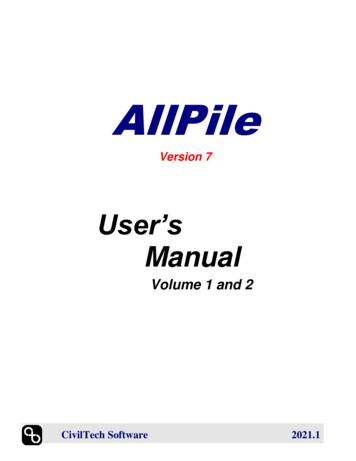





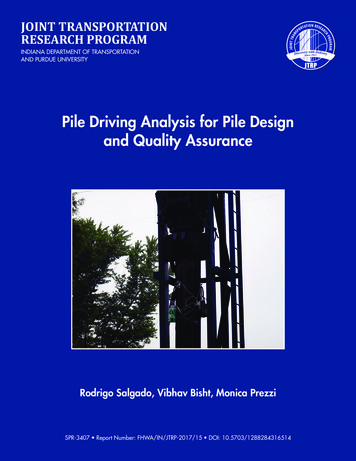
![Pile Foundation Design[1] - ITD](/img/29/pilefoundationdesign.jpg)

